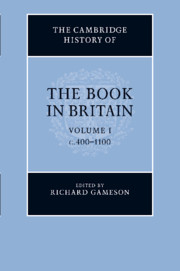Book contents
- Frontmatter
- 1 From Vindolanda to Domesday: the book in Britain from the Romans to the Normans
- PART I THE MAKING OF BOOKS
- PART II THE CIRCULATION OF BOOKS
- PART III TYPES OF BOOKS AND THEIR USES
- 15 The book in Roman Britain
- 16 The use of the book in Wales, c. 400–1100
- 17 The biblical manuscripts of Anglo-Saxon England
- 18 Anglo-Saxon gospel-books, c. 900–1066
- 19 Liturgical books
- 20 Anglo-Saxon prayerbooks
- 21 Psalters
- 22 Music books
- 23 Anglo-Saxon schoolbooks
- 24 Law books
- 25 Manuscripts of the Anglo-Saxon Chronicle
- 26 Old English homiliaries and poetic manuscripts
- PART IV COLLECTIONS OF BOOKS
- PART V CODA
- Bibliography
- Concordance of named manuscripts
- Index of manuscripts
- General Index
- Plate 4.1: The Lindisfarne Gospels"
- Plate 5.1: The Lichfield/St Chad Gospels"
18 - Anglo-Saxon gospel-books, c. 900–1066
from PART III - TYPES OF BOOKS AND THEIR USES
Published online by Cambridge University Press: 28 March 2012
- Frontmatter
- 1 From Vindolanda to Domesday: the book in Britain from the Romans to the Normans
- PART I THE MAKING OF BOOKS
- PART II THE CIRCULATION OF BOOKS
- PART III TYPES OF BOOKS AND THEIR USES
- 15 The book in Roman Britain
- 16 The use of the book in Wales, c. 400–1100
- 17 The biblical manuscripts of Anglo-Saxon England
- 18 Anglo-Saxon gospel-books, c. 900–1066
- 19 Liturgical books
- 20 Anglo-Saxon prayerbooks
- 21 Psalters
- 22 Music books
- 23 Anglo-Saxon schoolbooks
- 24 Law books
- 25 Manuscripts of the Anglo-Saxon Chronicle
- 26 Old English homiliaries and poetic manuscripts
- PART IV COLLECTIONS OF BOOKS
- PART V CODA
- Bibliography
- Concordance of named manuscripts
- Index of manuscripts
- General Index
- Plate 4.1: The Lindisfarne Gospels"
- Plate 5.1: The Lichfield/St Chad Gospels"
Summary
In this period Anglo-Saxon gospel-books are easily the most numerous of all surviving Latin biblical codices. Twenty volumes and one fragment survive. All save one have been dated to the last seventy years before the Norman Conquest, many of these being attributed to thirty or forty years c. 1000–40 (see list A at the end of this chapter). They are among the most luxurious of books with their use of gold, their generous layout, and extensive, innovative illustrations. Some are particularly close to each other, sharing scribes, a similar textual apparatus, and conventions in their ‘architecture’. This chapter will consider first their contents, their makeup and layout, their decoration and illustrations before examining where, when and why they were made.
A gospel-book at this period could have different accessory texts. It might open with a varied group of general prefaces and arcaded canon tables (Plate 18.5); each gospel could be introduced by a preface and chapter list; and the book could end with a capitulary or list of gospel readings for the year. Two of the general opening texts, the letter of Jerome to Pope Damasus, usually known by its first words Nouum opus, and the letter of Eusebius of Caesarea to Carpianus (Eusebius Carpiano), included an explanation of the concordance system, arranged in ten canons and devised by Eusebius for the gospels; these canon tables came at an early date to be enclosed under varied and beautiful arcades (Plate 18.5). The other two general introductory texts, known by their first words as Plures fuisse and Sciendum etiam, came from Jerome’s introduction to his commentary on Matthew, and discussed the four evangelists. The inclusion of these texts, and the order in which they appeared could differentiate the witnesses (see list B at the end of this chapter).
Keywords
- Type
- Chapter
- Information
- The Cambridge History of the Book in Britain , pp. 436 - 448Publisher: Cambridge University PressPrint publication year: 2011
- 2
- Cited by



